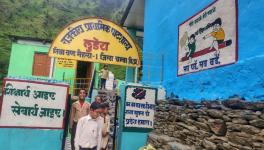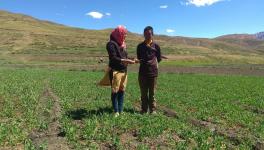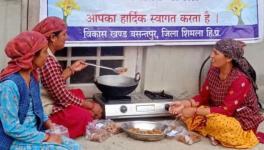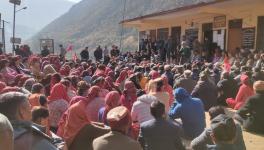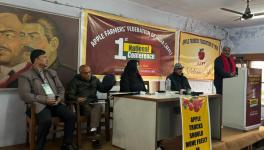HP: Adaptive Strategies Require a Dramatic Shift
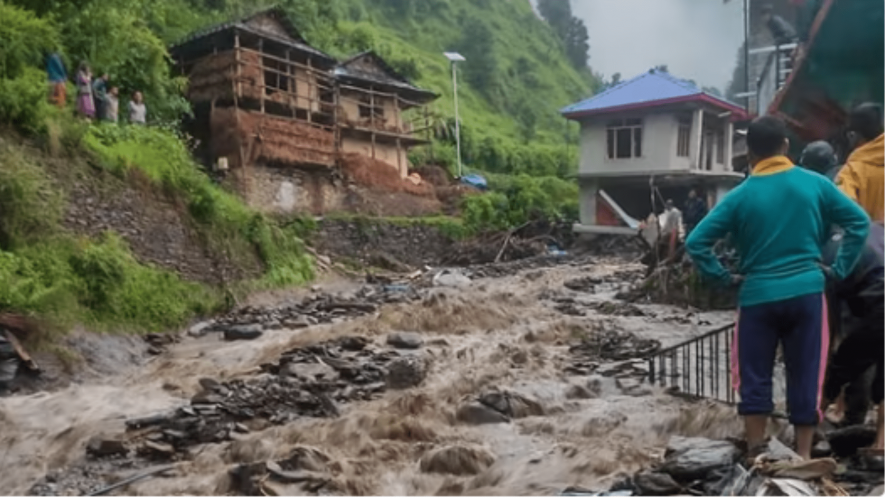
A flooded area following heavy rainfall, in Mandi district, Sunday, June 25, 2023. Image Courtesy: PTI
Charathgarh is a small town in the Una district of Himachal Pradesh. The recent images from this town, depicting a dead body floating in the cremation ground, are a stark reminder of the urgent need for adaptive strategies to minimise the loss resulting from climate change. With the onset of the monsoon season, regional newspapers are filled with front-page stories highlighting the damage caused by nature’s fury.
However, we must acknowledge that it is not solely nature’s fury that is responsible for the significant loss experienced. Reckless infrastructure development in the mountain regions' urban and rural areas, especially the Himalayas, is a major contributing factor. This ongoing development has led to colossal losses yearly, affecting assets, roads, bridges, houses, buildings, towns and villages throughout the region. Tragically, lives are also lost during these disasters.
The Delhi-Manali highway faces frequent blockages throughout the year. Similarly, numerous disasters are triggered by heavy rains in various parts of the country. For example, the char dham yatra highway in Uttarakhand was washed away in recent rains. These incidents further highlight the vulnerability of infrastructure and the urgent need for adaptive strategies to mitigate the impact of such disasters.
Adaptation is the key.
Adaptation is crucial in addressing the challenges posed by climate change. The Intergovernmental Panel on Climate Change(IPCC) Report VI and its three working groups clearly emphasise the urgent need for intervention. It is encouraging to see that climate scientists worldwide now recognise the problem's systemic nature.
The report underscores the importance of implementing significant adaptation strategies to minimise the loss resulting from climate change-induced disasters. In the developing world, building strong advocacy groups that advocate for a policy paradigm shift towards climate adaptability is essential. While climate mitigation and adaptation strategies are interconnected, it is crucial for the developing world and the least developed nations to focus on adaptability, as they experience the largest losses, despite contributing the least to climate change.
The report’s emphasis on adaptation highlights the need for comprehensive measures to address climate change impacts effectively. By prioritising adaptation strategies, nations can work towards minimising the adverse effects of climate-induced disasters and building resilience in vulnerable regions.
What does it mean by adaptability strategies? Adaptability strategies refer to measures and approaches aimed at reducing vulnerability and enhancing resilience in the face of changing environmental conditions, specifically related to climate change. In the context of the Indian Himalayan Region (IHR), adaptability strategies focus on addressing the challenges posed by climate change in the ecologically sensitive area.
The strong impetus from the centre for generating their own resources in the IHR states has led to a shift in development strategies towards areas that are not well-suited for the fragile Himalayan ecosystem. As a result, vulnerability in the region has increased over the past few decades, amplifying the impact of disasters. Despite advancements in communication and research, there continues to be a rise in fatalities and losses to assets.
The areas that require immediate attention in the IHR are:
∙ Hydropower generation
∙ Tourism
∙ Infrastructure Development
∙ Forest & Water
∙ Urbanisation
Sustainable Development in the IHR must be the overarching principle of development. Shifting the focus towards sustainable development practices that consider the unique characteristics of the Himalayan ecosystem. This includes careful infrastructure planning, resource management, land-use policies to minimise negative impacts, community engagement and capacity building.
The Himalayas are considered to be the powerhouse of India. There is massive potential for hydropower generation in this region. The IHR has the potential of generating 115,550 MW hydro energy. Various agencies, both private and public companies, are doing the current installed capacity of 46,850 MW. This report demonstrates the sheer linkages between the construction of these hydropower projects and disasters in the region.
The report states, “In Uttarakhand’s Joshimath town, where more than 800 buildings have developed cracks due to subsidence, the government on January 5, 2023, imposed a ban on construction activities, including on the works at Tapovan Vishnugad hydropower project. Anjal Prakash, research director at the Indian School of Business, Hyderabad, who was also the coordinating lead author of the 2002 Special Report by the Intergovernmental Panel on Climate Change, says that most of the existing or under-construction projects in the Himalayas were envisaged 10-15 years ago and there is a dire need to reevaluate these based on current scientific data. Both eastern and western Himalayan regions in India are part of a seismically active zone; scientists have been warning of a build-up of a major earthquake in Uttarakhand.”
Despite these stern warnings, the development strategy continues unabated.
Tourism is another major area that has an inherent duality in it. Whereas it serves as a bread-and-butter source for many of the population residing in the IHR, it is also building new social conflicts. There is more pressure on the natural resources. The infrastructure development model of four-lane highways attracts tourists, building typologies not akin to the mountain needs and decrying the mountain aesthetics in building typologies, all of which contribute to the rise in the incidence of loss due to natural disasters. Carrying capacity of tourism-related activities must be discussed and engaged with ensuring that the people are kept at the centre of such discussions.
Urbanisation in the mountain region is another major area that needs to be revisited. The copy-past models of the plains, the national building codes, mainly decided for the buildings in the flat regions, building typologies not suited for the mountains, the reinforced cement concrete structures, and other forms are the way in which mountains are being shaped. These are neither suited for the mountains nor adaptive to the mountain ecosystem and hence are extremely vulnerable from the disaster risk reduction perspective. The Hazard Risk Vulnerability Assessment (HVRA) report generated for Shimla town points towards the extreme form of vulnerability in the hilly town. It states that if an earthquake with a considerable magnitude strikes this hilly town during the day, there may be more than 18,000 deaths, but if it strikes during the night, the number might reach 23,000 people. The two most vulnerable buildings are the Himachal Pradesh High Court and the Indira Gandhi Medical College (IGMC), Shimla. Imagine there will not even be a place in the major hospital that will grapple with the disaster.
This is the story of almost every mountain town. The emphasis must be laid on retrofitting, ensuring a minimal loss in the advent of a disaster. Also, the building and development plans must be based on strong geological findings.
Alternative governance
Quite interestingly, if one visits the office of a Member of the Legislative Assembly (MLA) in Himachal Pradesh, for that matter, across the Himalayan region, two major works consume most of the elected official’s work. The first is transfers of the employees, and the second is Demi Official(DO) letters to the state and district bureaucracy demanding compensation to the town/village areas for the loss and damage that has occurred because of rain, floods etc. The loss mainly pertains to damage to roads, culverts, bridges in the towns, private and public buildings, crop loss, etc.
Getting such losses assessed and finally compensated takes months, if not years, together. Till that period, the people had to live by the loss, and this in mountain vocabulary is called “contentment” or resilience, etc.
A major disruption is required in this area. Just like there is the insurance of the human body, moveable and immovable assets like cars, houses, etc., it is high time that community-led insurance models are developed for insuring their village or town common assets.
These assets include roads, bridges, culverts, schools etc. The principal driver for such assets and insurance should be the village or town elected/community residents, not the government. These are huge assets that the towns and the village own but are not considered worth insurance.
A mechanism should be drawn where these assets, which are lost due to natural disasters, are compensated by reconstructing them quickly.
Take, for example, Himachal Pradesh. During the current monsoon period, two major economic activities are taking place. The harvest of ‘off-season vegetables’ in the regions of Solan, Sirmour, Hamirpur, and Kangra and another is the harvest of apples in districts of Shimla, Solan, Sirmour, Kullu, Kinnaur, Chamba etc. One single culvert, damaged or not repaired, will severely hit the farmers of a particular village.
Adaptability is not just a conceptual phenomenon linked to infrastructure adaptability and building community resilience through behavioural change. It is also how the economic and financial activities are adapted.
Adaptability for a better and secure future.
The writer is former Deputy Mayor of Shimla, Himachal Pradesh. The views are personal.
Get the latest reports & analysis with people's perspective on Protests, movements & deep analytical videos, discussions of the current affairs in your Telegram app. Subscribe to NewsClick's Telegram channel & get Real-Time updates on stories, as they get published on our website.









